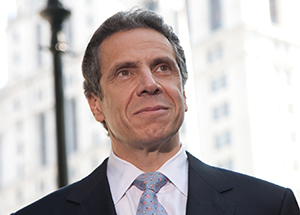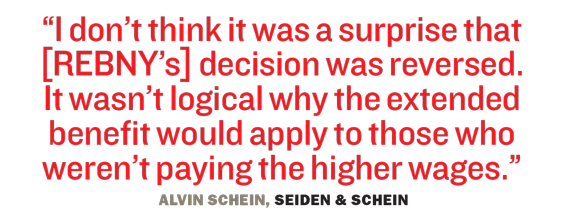Since June 2015, the fate of 421a has lain not with the New York State Legislature, which oversaw its renewal for more than four decades, but with two of the state’s largest lobbying groups: The Real Estate Board of New York and the Building and Construction Trades Council of Greater New York.
It was the first time the two behemoths had been forced to agree on a wage provision. Negotiations, perhaps unsurprisingly, faltered. When the controversial housing program — which saves developers more than a billion dollars in taxes every year — expired last January without a replacement, it left both the real estate industry and many affordable housing advocates (even some who had opposed it) ill at ease. That intensified as the months wore on with no sign of resolution.
Then, on Nov. 10, REBNY and Building Trades announced that their long stalemate over higher construction wages had been resolved. Real estate developers rejoiced, REBNY and Building Trades released self-congratulatory statements, and Gov. Andrew Cuomo applauded the agreement as “a major step forward for New Yorkers.”
It quickly became obvious, however, that the governor and the lobbies did not have a consensus on a new 421a deal. When the celebratory announcement went out, there was a substantial misunderstanding about which projects would qualify for the coveted 35-year tax abatement.
The misfire on the long-overdue accord was just the latest roadblock for the suspended tax law — a development incentive that mostly subsidizes market-rate housing along with some affordable.

Gov. Andrew Cuomo
Legislators had a renewal of 421a ready in the summer of 2015, but Cuomo said he would not sign the bill unless a wage provision for construction workers was added, introducing a new and volatile element to an already controversial program. When no agreement was reached, the abatement expired in January.
In the spring, Cuomo doubled down, saying that any bill the labor unions couldn’t get on board with would not make it past his desk. REBNY president John Banks and Building Trades boss Gary LaBarbera showed the public they were still miles apart at a May real estate panel hosted by Crain’s. And as the 2016 legislative session came to a close, New York State Republicans introduced a 421a replacement called 421aa that included some higher wage requirements, along with other changes more favorable to the real estate industry.
But LaBarbera found the REBNY-backed reforms — which didn’t significantly raise construction wages — laughable, calling the bill “absolutely ridiculous.”
“Thank you for giving the workers the minimum wage,” he told TRD in June 2016. “Are they really that out of touch?”
Nearly half a year later, the premature announcement of the latest 421a deal illustrates just how desperate the real estate community has been to reach an agreement and end the inexhaustible lobby war, even if they lacked a consensus on the terms.
It’s not surprising that many real estate players have been hesitant to celebrate the drama’s end.
“We don’t want to get too excited. Not yet,” said Alvin Schein, a real estate attorney who over many years has helped dozens of developers qualify for 421a.
False start
On Nov. 10, REBNY and Building Trades released a joint statement outlining the basic terms of its long-anticipated agreement on the renewal of 421a.
 The agreement gave the impression that developers would receive a critical tax exemption for 35 years (up from 25) on residential projects citywide. Additionally, construction workers would receive higher wages at select development sites that received the tax benefit, per the joint statement.
The agreement gave the impression that developers would receive a critical tax exemption for 35 years (up from 25) on residential projects citywide. Additionally, construction workers would receive higher wages at select development sites that received the tax benefit, per the joint statement.
After nearly a year without the legislation that many believe is critical to the construction of rental and affordable housing, things were seemingly back on track. Less than a week later, however, the tenuous peace deal appeared to be unraveling — just as it had in other near-agreements prior.
One industry source close to the negotiations told The Real Deal that a dispute over which projects qualified for the 35-year exemption had surfaced. REBNY initially interpreted the agreement to mean that the exemption would apply to all 421a projects across the city, even if the developer didn’t agree to wage requirements.
But an official from Cuomo’s office told Crain’s on Nov. 15 that REBNY had gotten it wrong. A Building Trades representative then told TRD the longer exemption would apply only to projects that paid higher wages to workers, while other projects would receive a 25-year tax break. REBNY, for its part, stuck with the 35-year-exemption-for-all line.
The difference was staggering: The lobbying group’s interpretation of the agreement would mean hundreds of millions of dollars more in future tax subsidies than the plan Cuomo and Building Trades thought they had agreed to.
Those higher-wage projects, in fact, would only be buildings of 300 units or more in Manhattan, south of 96th Street, and on the Brooklyn and Queens waterfronts, where workers would be paid a wage-plus-benefits average of $60 and $45 an hour, respectively.
Neither Building Trades nor Cuomo’s office issued a public statement — or copies of the agreement itself — to clear up the confusion. But the source close to the negotiations said the actual agreement clearly distinguishes that the 35-year exemption applies only to 300-plus-unit projects, in which construction workers receive higher wages. The language of the agreement, per the source, specifically states that “eligible buildings” for the longer exemption are only those with the wage requirement.
REBNY insisted that the language in its original announcement had been correct after TRD published a story on Nov. 16 about the discrepancy. When pressed further, the organization provided a statement from its president, John Banks, that rehashed the necessity of 421a for the creation of affordable housing without addressing the issue.
The governor’s office, however, maintained that REBNY and Building Trades’ initial release was incorrect. “The geographic region outside of the wage zone was never part of the discussion,” a high-ranking administration official, who asked not to be named, said.
By the end of the day, REBNY had backed down from its stance that all 421a projects would receive the 35-year tax exemption.
“There was a misunderstanding between the parties regarding the 35-year provision of the 421a agreement announced last week,”
Jamie McShane, REBNY’s vice president, said in a statement, implying that Cuomo and Building Trades were part of the misunderstanding.
“The REBNY Executive Committee agreed today that, in the interest of getting legislation passed that will reinvigorate the production of new rental housing, including a substantial number of affordable units, the 35-year tax exemption should only apply to those projects that participate in the wage and benefit agreement,” McShane’s statement read.
 It’s still unclear how the line-crossing occurred and why it wasn’t resolved more quickly — REBNY and Building Trades representatives did not respond to further requests for comment.
It’s still unclear how the line-crossing occurred and why it wasn’t resolved more quickly — REBNY and Building Trades representatives did not respond to further requests for comment.
The official from the governor’s office has since confirmed that at no time during negotiations was any change that did not involve wage increases up for discussion.
“From our end, there was no confusion,” the official told TRD. “You could argue that we’re all in much better shape than we were before. If it had gone forward and there was just a silent misunderstanding between parties as it went to a legislative session, that could have been a real problem.”
The confusion left many in the industry scratching their heads. One government relations attorney said REBNY gave every indication that the extended term of the tax exemption was to apply to all projects, not just those in prime development zones paying higher wages.
“This is really a surprise to us,” the attorney said on the condition of anonymity.
But others said they read the REBNY press release and knew it didn’t add up.
“I don’t think it was a surprise that [REBNY’s] decision was reversed,” Schein noted. “It wasn’t logical why the extended benefit would apply to those who weren’t paying the higher wages.”
A flawed program
Before the lobbyist drama even started, many had called for 421a to be scrapped and replaced with an entirely new affordable housing program. Critics pointed out that the program — which started in 1971 as a development incentive without an affordable housing component and was reconfigured into one as the city’s fortunes improved — was poorly designed for that purpose. Especially given the nearly $600,000 that the city’s Department of Housing Preservation and Development says each affordable unit costs to build under 421a.
But few were happy with the program’s abrupt expiration, especially without a superior successor in place. Mayor Bill de Blasio, for one, has had to watch the 421a drama from the sidelines for the past year and a half. Although he was active in the public debate over the program and has squabbled extensively with Cuomo over it, the tax law is largely out of his hands.
Nonetheless, the currently suspended bill passed by the state legislature last year resembles de Blasio’s own, REBNY-backed proposal for 421a — with the notable exception of the wage provision.
Developers and brokers have maintained that without a deal in place, building new rental housing in the outer boroughs would be next to impossible. The so-called death of 421a was blamed for a 30 percent drop in dollar volume in Brooklyn’s investment sales market, and developers opted to abandon or delay major projects.
The Durst Organization [TRDataCustom], for example, announced in February that it would hold off on the second phase of its $1.5 billion Hallets Point residential project, stating: “Without the abatement, the economics for the project collapse.”

A rendering of Hallets Point
Leading up to the first expiration of the tax cut in June 2015, a record number of building permits were issued by the city as developers panicked that they would miss out on millions of dollars in benefits if 421a fell through. When it was extended for six months, the permit approvals again shot through the roof at the end of the year.
David Schwartz, a principal at Slate Property Group, said that while other factors such as a tightening construction financing market had hurt rental development, 421a was certainly a factor. “Everyone kind of put everything on hold until something happened,” he said.
As for the new covenant announced last month, some of it resembled the 421aa bill that Senate Republicans tried to pass at the end of the last legislative session. That proposal called for a slightly lower average hourly wage for large Manhattan projects of 300-plus units ($55 rather than $60), but unlike the current agreement, it extended the lifetime of exemptions to up to 35 years at all projects, not just high-wage ones.
Renewal ramifications
REBNY and the governor’s office seem to agree that the new bill will largely take the form of the June 2015 agreement, but November’s fumble calls into question how ready a 421a bill will be — even if a special legislative session is called. Although the legislation has been held up by REBNY and Building Trades’ negotiations, a bill still needs to make its way through the state legislature. And the legislature has shown little interest in calling a special session to resolve the issue before January, according to recent reports.
“I don’t know if everything’s been worked out, and I’m not sure why we would rush to do something in December that we could do a few weeks later in January and maybe get it right,” Assemblyman Jeff Dinowitz, a Democrat from the Bronx, told Politico.
It’s unclear — if the bill does pass — how beneficial it will be for unions and affordable housing construction, or if the lion’s share of benefits will accrue to developers, as critics say they have in the past.
A spokesman for the de Blasio administration said that while they had yet to review all the details, “our priority is ensuring that the ultimate legislation passed demands real affordable housing for our people and protects taxpayers from giveaways.”
The accord is also a far cry from the initial demands of union groups, who sought prevailing wage requirements for construction workers on most projects that qualified for the tax break. Conversely, the wage requirement in the latest proposal won’t apply to the bulk of projects that qualify for 421a, and it won’t guarantee that developers turn to union labor at a time when non-union shops are gaining considerable ground.
Edward Ott, a labor expert at the City University of New York and former executive director of the New York City Central Labor Council, said that the agreement, though a compromise, may encourage more developers to hire union workers for affordable housing projects.
“Is it everything the unions wanted? Probably not. And I don’t think it’s everything that the developers wanted either,” he told TRD. “Now we get to see if it works at all.”
LaBarbera was more optimistic. The Building Trades president wrote in a statement that the agreement would ensure unions’ “long-term competitiveness in the industry.”
Even if the unions fell short of achieving their more ambitious goals, the long détente with REBNY led to some concessions from the largest developers in New York — a sign to many that construction now has a much more serious seat in Albany.
David Pfeffer, a partner at Tarter Krinsky & Drogin, noted that unions have been throwing their weight around Albany, lobbying delegates and legislators to oppose other real estate-related legislation until minimum wages were inserted into programs like 421a.
“There was never a wage requirement in the law at all,” Pfeffer said. “So it’s a win for them.”
Union dues
If minimum wages for large 421a projects in prime locations are greatly increased, many are hopeful that developers of such projects will be more likely to choose union labor. Unions have also made some changes in an attempt to compete with the prices offered by open-shop labor. This includes creating a “blended-rate” workforce by adding more employees who are paid at a lower rate than the highly skilled journeymen and eliminating certain fringe benefits.
But others, including de Blasio, have criticized LaBarbera’s prevailing wage crusade for cutting into affordable housing. “The only way to achieve those goals is with an appropriate wage level for the creation of affordable housing, which obviously is not based on the profit motive,” de Blasio told the Daily News last year.
Charles Bendit, co-CEO of Taconic Investment Partners, said the proposal “seems reasonable” and a welcome step toward restoring the tax abatement program. As for the wage requirement, Bendit said for a large project, including the 352-unit residential development his company plans for 52nd Street, Taconic is more likely to use union labor anyway.
Ross Moskowitz, an attorney at Stroock & Stroock & Lavan, said the deal shows that labor, real estate and Cuomo are ready to move on with what they have.
“If it reveals anything, it’s that they came up with a solution that they can all live with,” he said.
How much the deal will spur affordable housing development remains a mystery. A representative for the Durst Organization said the company is still reviewing the proposal, when asked about its stalled Hallets Point project.
But affordable housing activists and tenant-rights groups might point to projects such as Hallets Point as proof that 421a — which banks affordable housing creation on developers — is not an effective means of building affordable housing.
“We’re hoping the proposal does not go through,” said Katie Goldstein, a senior organizer of the Tenants & Neighbors activist group. “We see that 421a is going to cost billions a year in tax dollars.”
Renata Pumarol, of the community organizing group New York Communities for Change, said the group considers 421a to be “a tremendous waste of money.”
“We’re giving a tax abatement,” she said, “but we are not getting deeply affordable housing.”

Eliot Spitzer
Even former New York governor and current real estate developer Eliot Spitzer has said he thinks 421a is a bust for affordable construction. At the Young Men’s and Women’s Real Estate Association luncheon in November, he told an audience that “421a doesn’t work.”
“If you look at the number of units we are getting and the cost per unit, it simply isn’t giving us the outcome we need,” Spitzer said.
Still, he made it clear the program is necessary for the construction of rental housing at the $700 million mixed-use complex his firm is developing along the Williamsburg waterfront. While 421a may not be the best tool for building affordable housing, no one, including Spitzer, has ever doubted that real estate developers will make good use of it.
“Without 421a, it is inconceivable that we would have done our project as a rental,” he said at the panel days before REBNY and Building Trades announced their pact. “We could have done it as a condominium without 20 percent inclusionary. We could have done very nicely.”
